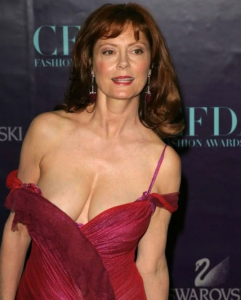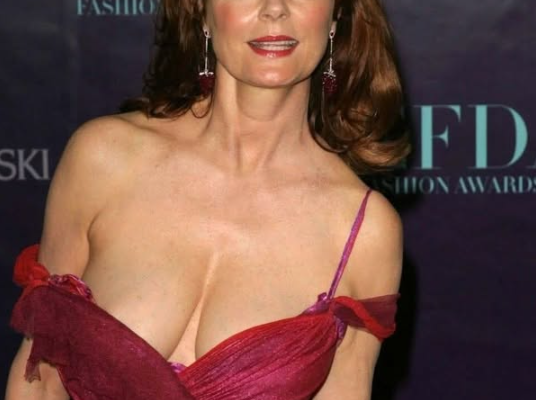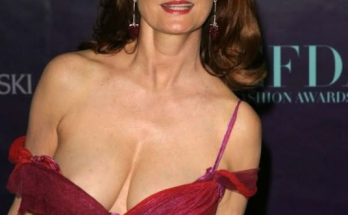
Susan Sarandon, the award-winning actress celebrated for her decades-long career in Hollywood, has recently found herself at the center of an unexpected controversy—not for a film role, political statement, or social activism, but for her clothing choices. At 78 years old, Sarandon remains a visible figure in the public eye, attending premieres, award shows, and social events with a confidence and style that reflects her unique personality. Yet, some social media users and commentators have taken issue with her fashion, sparking conversations about ageism, cultural expectations, and the boundaries of personal expression.
Sarandon’s style has always been eclectic. From the rebellious roles she took in her early career to her more refined appearances on the red carpet, she has never been one to conform strictly to mainstream fashion norms. Her clothing choices are often characterized by bold colors, flowing fabrics, and a willingness to mix high fashion with vintage or unconventional pieces. This independence in style has been a hallmark of her public persona, symbolizing both confidence and creative freedom. However, in the context of social media today, where scrutiny can be instantaneous and sometimes harsh, such individuality has drawn criticism from those who believe a certain age comes with “expectations” of how one should dress.
The criticism directed at Sarandon is not isolated; it is part of a broader pattern in which older women in the public eye are judged more harshly than their younger counterparts. While young actresses and celebrities are frequently praised for daring fashion choices, older women often face unsolicited commentary suggesting that they should dress more conservatively or adhere to societal norms of modesty or restraint. Sarandon, known for her outspoken personality and commitment to authenticity, has been both praised and critiqued for defying these unwritten rules. Her critics argue that her clothing choices are inappropriate for her age, while supporters contend that such judgments are inherently sexist and ageist.
Social media platforms have amplified these debates. Photos of Sarandon at events, wearing flowing gowns, colorful prints, or statement accessories, have been widely shared, accompanied by comments ranging from admiration to disapproval. Some commentators focus on perceived immodesty, while others critique the combination of colors or the cut of the garments. Such criticisms reflect a cultural bias that equates youth with fashion freedom and maturity with restraint. They also highlight a troubling trend in which public discourse disproportionately scrutinizes the appearances of women over 50, ignoring personal expression and reducing identity to aesthetic judgments.
Beyond societal pressures, Sarandon’s response to criticism exemplifies her longstanding philosophy of self-expression. Known for her advocacy on issues ranging from human rights to political engagement, she has consistently emphasized authenticity over conformity. Her approach to fashion mirrors this ethos. Clothing, for Sarandon, is not simply about appearances; it is a medium of communication, an extension of personality, and a statement of independence. By continuing to dress in ways that resonate with her sense of self, she challenges cultural assumptions that limit older women’s visibility and freedom in public spaces.
Fashion experts observing the controversy note that Sarandon’s choices align with principles of age-inclusive style, which emphasize comfort, elegance, and individuality over adherence to arbitrary norms. Flowing fabrics, layered ensembles, and vibrant colors are practical and flattering for mature bodies while allowing creative expression. Moreover, Sarandon’s confidence in her choices underscores a larger trend among older celebrities who refuse to allow age to dictate their fashion narratives. Figures like Helen Mirren, Viola Davis, and Meryl Streep have similarly embraced bold clothing, proving that style evolves with age rather than disappearing altogether.
The debate over Sarandon’s clothing also touches on generational differences in fashion perception. Younger audiences may see her outfits as inspiring, fearless, and empowering, while some older or more traditional observers may perceive them as unconventional or inappropriate. This tension illustrates how cultural norms around aging, beauty, and presentation are not static but contested. Sarandon, by continuing to embrace her personal style, serves as a visible figure in these cultural negotiations, challenging stereotypes and encouraging dialogue about what it means to age with dignity and individuality.
Critics often overlook the context in which Sarandon’s clothing is worn. Red carpet events, film premieres, and awards ceremonies are environments where creativity and artistry are celebrated. Within these settings, sartorial experimentation is not only acceptable but encouraged. Sarandon’s fashion choices, therefore, can be seen as consistent with the spirit of such occasions—dynamic, expressive, and visually engaging. That some members of the public interpret her style as inappropriate says more about societal discomfort with older women exercising choice than about the clothing itself.
The conversation around Sarandon’s clothing is emblematic of broader societal tensions involving age, gender, and visibility. Women over 70 occupy a paradoxical space in the public eye: celebrated for their wisdom and achievement yet scrutinized for their appearance. This duality places unfair pressure on older women to navigate expectations of both respectability and relevance, often constraining self-expression. Sarandon’s willingness to reject these constraints highlights the importance of autonomy and challenges deeply ingrained biases that equate aging with diminished style or desirability.
Ultimately, the discourse surrounding Susan Sarandon’s clothing choices raises questions about the intersection of fashion, identity, and social norms. It invites reflection on why age becomes a limiting factor in perceptions of beauty and style, and why women in particular face disproportionate judgment. By maintaining her personal aesthetic, Sarandon offers a counter-narrative that celebrates individuality, confidence, and authenticity, reminding the public that fashion is a form of self-expression that transcends chronological age.
In conclusion, the criticism of 78-year-old Susan Sarandon for her clothing illuminates ongoing societal challenges regarding ageism, gender expectations, and the policing of personal style. Far from detracting from her presence, her clothing choices reinforce her lifelong commitment to authenticity, creativity, and personal empowerment. Sarandon demonstrates that style is not confined by age and that clothing can serve as a medium of self-expression, confidence, and cultural commentary. Her example encourages a broader rethinking of how society views older women in the public eye, fostering a more inclusive understanding of fashion, identity, and human dignity.
By embracing her individuality, Susan Sarandon continues to inspire both admiration and debate, proving that age need not limit creativity, style, or public visibility. In the end, the controversy over her clothing is less about fabric and design than about societal discomfort with women claiming autonomy over their bodies and appearances—a conversation that Sarandon’s presence in the spotlight helps advance with grace, intelligence, and courage.

